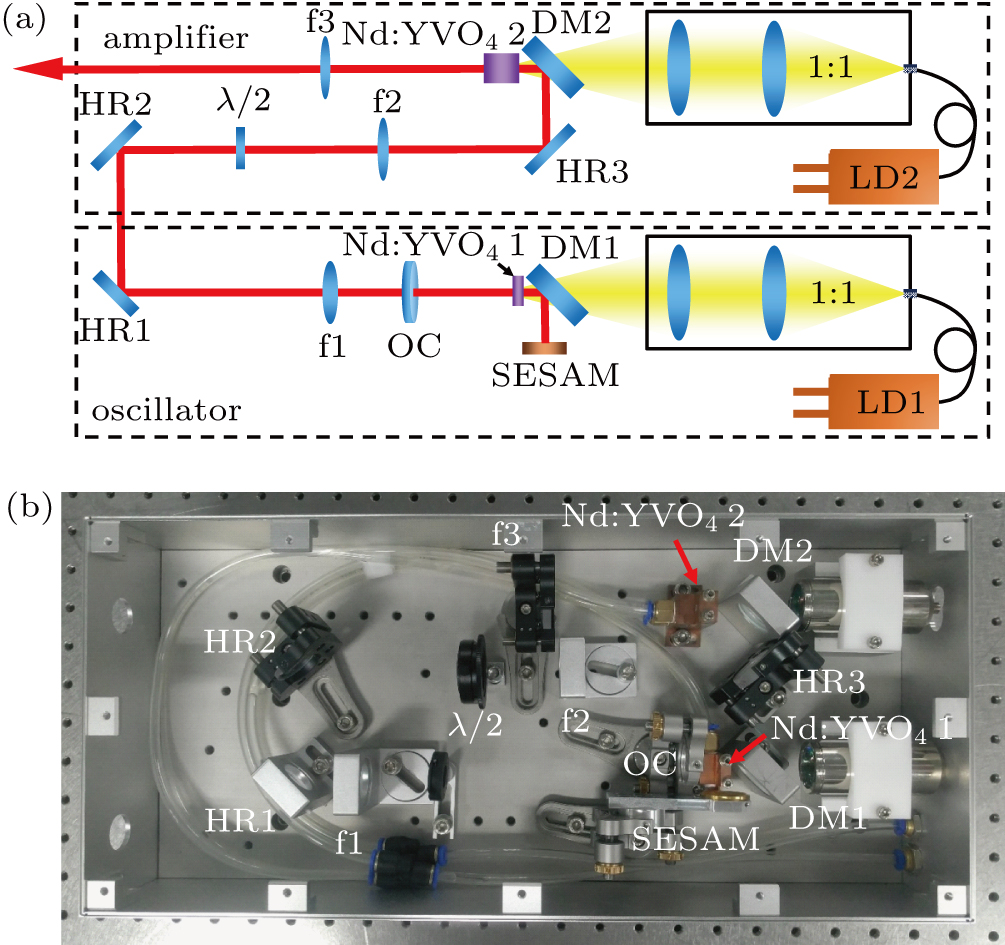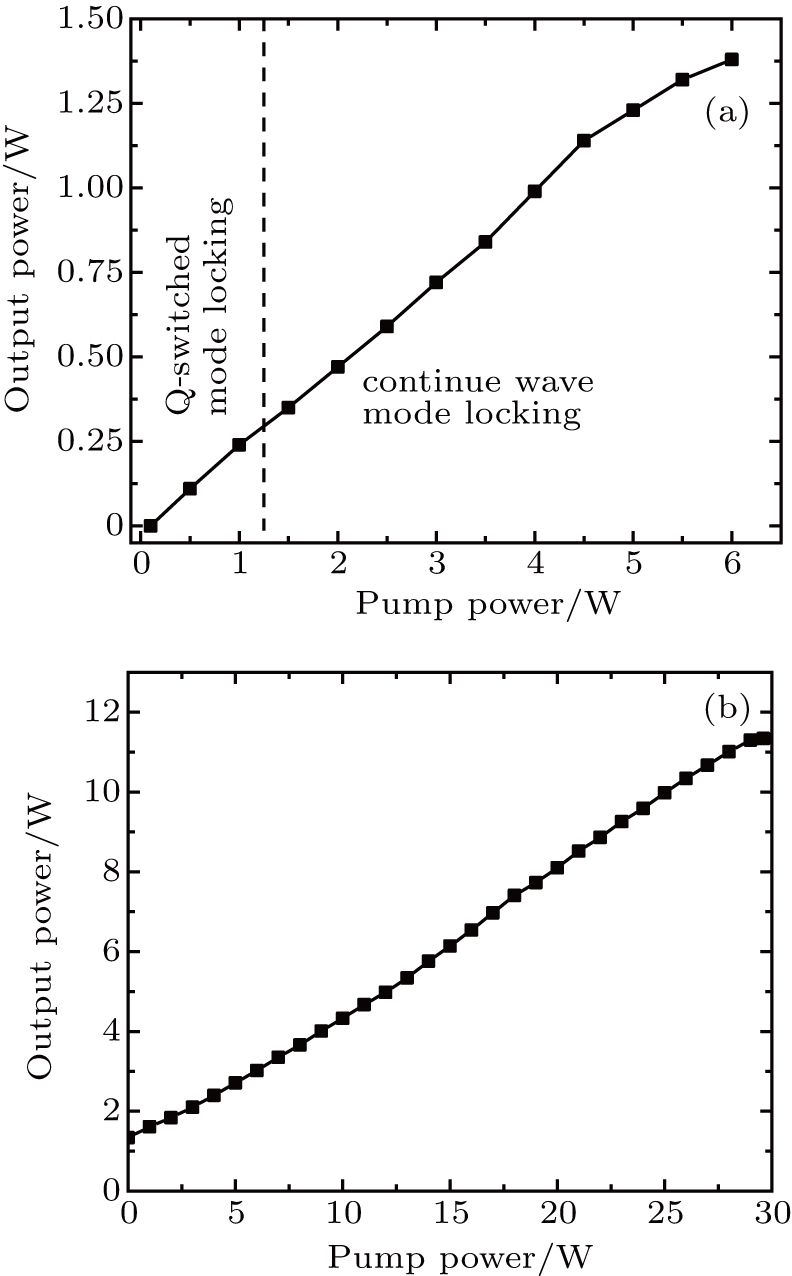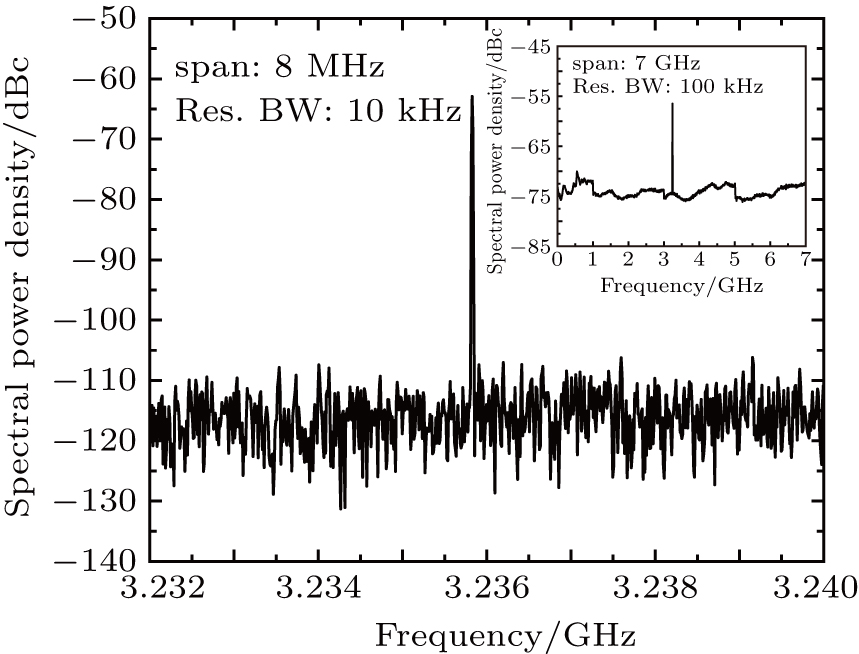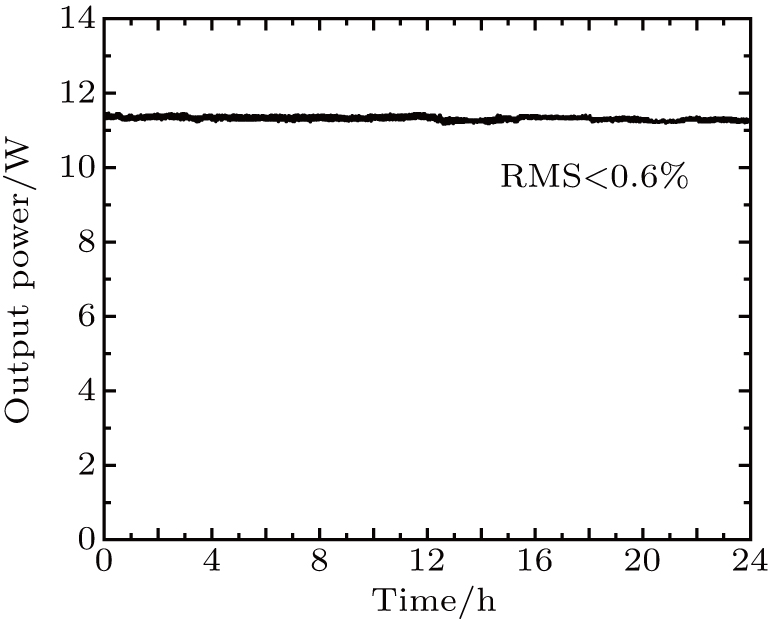† Corresponding author. E-mail:
Project supported by the Strategic Priority Research Program of Chinese Academy of Sciences (Grant No. XDB16030200), the National Natural Science Foundation of China (Grant Nos. 11774410 and 61575217), the National Key Scientific Instruments Development Program of China (Grant No. 2012YQ120047), and the Key Research Program of Frontier Sciences of Chinese Academy of Sciences (Grant No. KJZD-EW-L11-03).
A compact high power diode-pumped passively mode-locked Nd:YVO4 laser with high repetition rate is realized. Using an Nd:YVO4 crystal and a semiconductor saturable absorber mirror (SESAM) in the oscillator, the picosecond pulse output with an average power of 1.38 W, a repetition rate of 3.24 GHz, and a pulse duration of 11.4 ps is achieved. After one stage of amplification, the final output power reaches 11.34 W, corresponding to a total optical-to-optical efficiency of about 32%. The root mean square (RMS) value of power fluctuation is demonstrated to be less than 0.6% in 24 hours, showing a superior stability with the compact configuration.
Ultrashort laser pulses with high-repetition-rate are needed in many applications, such as biological image,[1] high-speed optical communication,[2] and high-repetition-rate optical frequency comb.[3] Laser diode (LD) pumped all-solid-state lasers have proven to be efficient and compact laser sources, and Nd:YVO4 crystal with large emission cross-section[4] is an ideal gain medium to achieve high-gain amplification. Short cavity with a semiconductor saturable absorber mirror (SESAM) is the most common way to achieve high repetition rate picosecond lasers. To realize continue wave mode locking instead of Q-switched mode locking (QML), the intracavity pulse energy Ep should exceed a threshold given by[5]


Using an Nd:YVO4 crystal and a short cavity, Krainer et al. first achieved a diode-pumped mode-locked laser with a repetition rate of 10 GHz and an average power of 2 W.[6] They also reported a 29-GHz 81-mW[7] mode-locked laser output by using an Nd:YVO4 crystal, one of the surfaces had a curvature and coated with a partial reflectivity, serving as an output mirror. By reducing the length of the Nd:YVO4 crystal and using a high brightness Ti:sapphire laser as the pump source, they finally achieved a laser with a repetition rate of 160 GHz and an average power of 110 mW.[6] Using this structure, Lecomte et al. realized a diode-pumped mode-locked laser with a repetition rate of 40 GHz and an average power of 288 mW.[8] Other approaches can also realize high-repetition-rate picosecond lasers. Liang et al. demonstrated a Kerr-lens mode-locked diode-pumped Nd:YVO4 laser with a repetition rate of 6 GHz and an average power of 0.8 W.[9] Other kinds of gain media have also been demonstrated to be used to generate the high-repetition-rate picosecond lasers. Using an Nd:GdVO4 crystal, Krainer et al. achieved a compact diode-pumped mode-locked laser with an average power of 0.5 W and a repetition rate of 10 GHz,[10] and Agnesi et al. reported a 2.5 GHz–2.7 GHz diode-pumped mode-locked laser with an average power of 250 mW.[11] Using a semiconductor as a gain medium, Haring et al. realized a 6-GHz passively mode-locked semiconductor laser with an average power of 950 mW.[12]
In this paper, we report a high repetition rate picosecond Nd:YVO4 laser with a high average power output. The laser system is comprised of an oscillator and an amplifier. Two fiber-coupled LDs are used to pump the oscillator and the amplifier separately. The oscillator is a short cavity including a 2-mm long Nd:YVO4 crystal and as SESAM. Under 6 W of the pump power, we achieve a 1.38-W laser output with a repetition rate of 3.24 GHz and pulse duration of 11.4 ps at 1064 nm. A special pumping geometry in the oscillator is designed to avoid direct pump-light incidence on the SESAM, and a long-term stable operation is achieved. Using a stage of amplifier based on a 10-mm-long Nd:YVO4 crystal, final output power of 11.3 W is obtained with pump power of 29.6 W. The total optical-to-optical efficiency is about 32%. Both oscillator and amplifier are placed in an aluminum case whose footprint is only 456 mm×206 mm, and their power stability within 24 hours is less than 0.6% (RMS).
Figure 

 | Fig. 1. (a) Experimental setup of passively mode-locked Nd:YVO4 laser and amplifier, and (b) hotograph of the whole laser system. Footprint of the case is only 456 mm×206 mm. |
In the oscillator, a short cavity with an SESAM, a dichroic mirror (DM1), a gain medium (Nd:YVO4 1), and an output coupler (OC) were used to achieve a high-repetition-rate output. In previous high-repetition-rate experiments, the pump beam was injected directly into the crystal and SESAM through the OC.[6] The unabsorbed pump laser heated the SESAM and the mirror holder which led to a long-term instability. In our experiment, a plane 45° dichroic mirror (DM1) with antireflection coating at 808 nm and high reflectance coating at 1064 nm was used to avoid pump beam directly entering into the SESAM for a long-term stable operation. A 2-mm long, 1-at.% a-cut Nd-doped YVO4 (Nd:YVO4 1) crystal with a cross-section of 3 mm×5 mm was used as the laser medium of the oscillator. A commercially available SESAM with a lower modulation depth of 0.4%, non-saturable loss of 0.3%, saturation fluence of 

Two 45° high-reflection mirrors (HR1, HR2) were used to guide the laser from the oscillator into the amplifier. The amplifier stage was an end-pumped single-pass amplifier including two planar-convex lenses (f2, f3), a 45° high reflection mirror (HR3), a curvature-free 45° dichroic mirror (DM2), and a gain medium (Nd:YVO4 2). Before the amplifier stage, a half-wave plate was used to finely adjust the polarization direction of the input laser for achieving higher efficiency amplification. The gain medium of the amplifier was a 10-mm-long, 0.3-at.% a-cut Nd-doped YVO4 (Nd:YVO4 2) crystal with a cross-section of 3 mm×3 mm, and the longer crystal could reduce the influence of the heat[13,14] and realize higher average power and better beam quality. Two planar-convex lenses (f2, f3) each with a focal length of 200 mm and antireflection coating at 1064 nm were used to achieve mode-matching and alignment of the amplified laser.
After carefully adjusting the OC and the SESAM in the oscillator, the high repetition rate laser can be observed behind the OC. With the help of the laser from the oscillator, the adjustment of the amplifier and high average power output can be achieved. Figure
 | Fig. 2. (a) Mode-locked output power versus pump power in the oscillator, and (b) final output power versus pump power in the amplifier. |
In the oscillator, the lasing threshold is below 100 mW of the pump power. The Q-switching instabilities are observed before the mode-locking threshold. And the stable self-staring continuous wave (CW) mode-locking is obtained at 1.5 W of the pump power. The stable CW mode-locking with average output power of 1.38 W is achieved under the pump power of 6 W, corresponding to an optical-to-optical efficiency of about 23%. For higher pump power, the stable CW mode-locking is broken. In the amplifier, the average input power is 1.34 W due to the loss of the optical components between the oscillator and the amplifier. At the max pump power of 29.6 W, the input laser is amplified to 11.34 W. The optical-to-optical efficiency in the amplifier is about 34% and the total optical-to-optical efficiency is about 32%.
By an ultrafast photodiode (UPD-70-UVIR-D, ALPHALAS GmbH) and a spectrum analyzer (FSW26, R&S), we measured the RF spectrum of the laser at full output power (11.34 W) as shown in Fig.
 | Fig. 3. RF spectrum of the output laser after amplifier at full output power (11.34 W), with inset showing RF spectrum with 7-GHz frequency span. |
Figure
 | Fig. 4. Autocorrelation with sech2 fit of output laser after amplifier at full output power (11.34 W). |
In this work, a special pumping geometry and an aluminum case are used to realize long-term stable operation, and we measured the power stability of the laser for 24 hours as shown in Fig.
In this work, we demonstrate a high-average-power picosecond Nd:YVO4 laser at 3.24 GHz. It is comprised of an oscillator and amplifier. Two fiber-coupled laser diodes are used to pump the oscillator and the amplifier, respectively. The oscillator had a short cavity including a 2-mm-long Nd:YVO4 crystal and an SESAM. Under 6 W of the pump power, we achieve a laser output with an average power of 1.38 W, a repetition rate of 3.24 GHz, and pulse duration of 11.4 ps at 1064 nm from the oscillator. To avoid direct pump light incidence on the SESAM, a special pumping structure is used in the oscillator. Further amplify the laser based on a 10-mm-long Nd:YVO4 crystal, then the output laser pulse will increase to an average power of 11.34 W under pump power of 29.6 W. The total optical-to-optical efficiency is about 32%. Both oscillator and amplifier are placed in an aluminum case whose footprint is only 456 mm×206 mm for long-term stable operation. The RMS value of power fluctuation in 24 hours is less than 0.6%. Furthermore, a shorter cavity can be used in the oscillator to realize even higher repetition rate and more stages in the amplifier for even higher average power. Our results may supply the wide applications in many fields such as high-repetition-rate second harmonic generation, high-repetition-rate optical parametric oscillator, etc.
We thank Hao Teng, Shaobo Fang, Hainian Han, and Dehua Li for their helpful discussion.
| [1] | |
| [2] | |
| [3] | |
| [4] | |
| [5] | |
| [6] | |
| [7] | |
| [8] | |
| [9] | |
| [10] | |
| [11] | |
| [12] | |
| [13] | |
| [14] |


